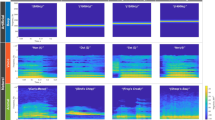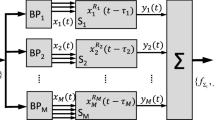Abstract
We propose a novel method for the extraction of discriminative features in electroencephalography (EEG) evoked potential latency. Based on our offline results, we present evidence indicating that a full surround sound auditory brain–computer interface (BCI) paradigm has potential for an online application. The auditory spatial BCI concept is based on an eight-directional audio stimuli delivery technique, developed by our group, which employs a loudspeaker array in an octagonal horizontal plane. The stimuli presented to the subjects vary in frequency and timbre. To capture brain responses, we utilize an eight-channel EEG system. We propose a methodology for finding and optimizing evoked response latencies in the P300 range in order later to classify them correctly and to elucidate the subject’s chosen targets or ignored non-targets. To accomplish the above, we propose an approach based on an analysis of variance for feature selection. Finally, we identify the subjects’ intended commands with a Naive Bayesian classifier for sorting the final responses. The results obtained with ten subjects in offline BCI experiments support our research hypothesis by providing higher classification results and an improved information transfer rate compared with state-of-the-art solutions.




Similar content being viewed by others
References
Wolpaw J, Wolpaw EW, editors. Brain–computer interfaces: principles and practice. Oxford: Oxford University Press; 2012.
Schnupp J, Nelken I, King A. Auditory neuroscience: making sense of sound. Cambridge: MIT Press; 2010.
Rutkowski TM, Cichocki A, Mandic DP. Spatial auditory paradigms for brain computer/machine interfacing. In: International workshop on the principles and applications of spatial hearing 2009 (IWPASH 2009). Proceedings of the international workshop. Miyagi-Zao Royal Hotel, Sendai, Japan; 2009. p. P5.
Schreuder M, Blankertz B, Tangermann M. A new auditory multi-class brain-computer interface paradigm: spatial hearing as an informative cue. PLoS ONE. 2010;5: e9813.
Cai Z, Terasawa H, Makino S, Yamada T, Rutkowski TM. Sound timbre and spatial location as informative cues in auditory BCI—brain evoked potential enhancement and involuntary eye movements artifacts suppression approach. In: Proceedings of the third APSIPA annual summit and conference (APSIPA ASC 2011). Xi’an, China: APSIPA; 2011. p. paper #241.
Schomer DL, Lopes da Silva FH, editors. Niedermeyer’s electroencephalography: basic principles, clinical applications, and related fields. Wolters & Kluwer, Lippincott Williams & Wilkins, 6th ed; 2011.
Jurcak V, Tsuzuki D, Dan I. 10/20, 10/10, and 10/5 systems revisited: their validity as relative head-surface-based positioning systems. NeuroImage. 2007;34:1600–1611.
Rutkowski TM. Auditory brain-computer/machine interface paradigms design. In: Cooper E, Kryssanov V, Ogawa H, Brewster S, editors, Haptic and audio interaction design. Lecture notes in computer science, vol 6851. Berlin/Heidelberg: Springer; 2011. pp. 110–119.
Schreuder M, Rost T, Tangermann M. Listen, you are writing! Speeding up online spelling with a dynamic auditory BCI. Front Neurosci. 2011;5: Article 112.
Hoehne J, Schreuder M, Blankertz B, Tangermann M. A novel 9-class auditory ERP paradigm driving a predictive text entry system. Front Neurosci. 2011;5: Article 99.
Cai Z, Makino S, Rutkowski TM. Multichannel analysis of ERP at early and P300 latencies in application for spatial auditory BCI improvement. In: Proceedings of the fourth APSIPA annual summit and conference (APSIPA ASC 2012). Hollywood, CA, USA: APSIPA; 2012. p. paper #355.
Mitchell TM. Machine Learning. New York: McGraw-Hill; 1997.
Schloegl A, Kronegg J, Huggins J, Mason SG. Evaluation criteria in BCI research. In: Dornhege G, Millan J, Hinterberger T, DJ McFarland KR, editors. Towards brain-computer interfacing. Cambridge: MIT Press; 2007. pp. 327–342.
Acknowledgments
This research was supported in part by the Strategic Information and Communications R&D Promotion Program No. 121803027 of The Ministry of Internal Affairs and Communication in Japan and by KAKENHI, the Japan Society for the Promotion of Science, Grant Nos. 12010738 and 24700154. We also acknowledge the technical support of YAMAHA Sound & IT Development Division in Hamamatsu, Japan.
Author Contributions
Zhenyu Cai, Tomasz M. Rutkowski: Performed the EEG experiments and analyzed the data. Tomasz M. Rutkowski: Conceived the concept of the spatial auditory BCI and designed the EEG experiments. Shoji Makino: Coordinated and supported the project. Zhenyu Cai, Tomasz M. Rutkowski: Wrote the paper.
Author information
Authors and Affiliations
Corresponding author
Rights and permissions
About this article
Cite this article
Cai, Z., Makino, S. & Rutkowski, T.M. Brain Evoked Potential Latencies Optimization for Spatial Auditory Brain–Computer Interface. Cogn Comput 7, 34–43 (2015). https://doi.org/10.1007/s12559-013-9228-x
Received:
Accepted:
Published:
Issue Date:
DOI: https://doi.org/10.1007/s12559-013-9228-x




